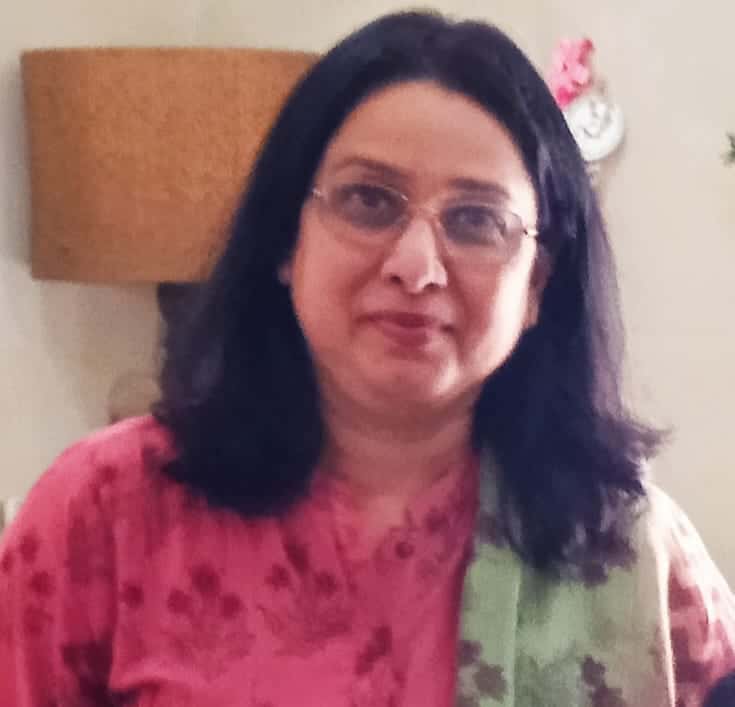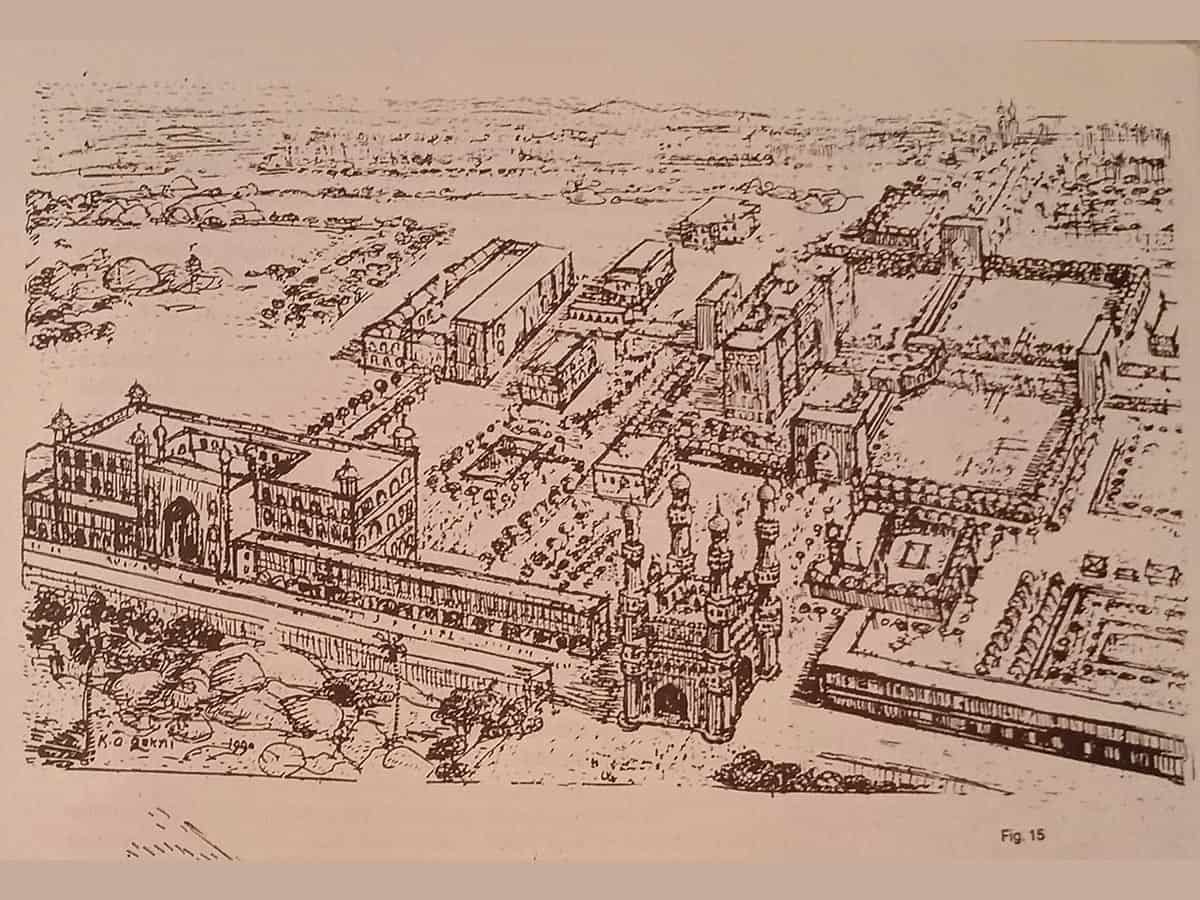
It is not that contemporary and later historians have not written about the Qutb Shahi palaces but it is only when material culture is present before us, do we award it the recognition it deserves. This is that chapter of Hyderabad’s glorious past that many are not aware of. The Qutb Shahi Golconda-Haidarabad was divided into four major sectors comprising the sultans’ palaces, the nobles’ residences, the bazaars, and the military encampments. What is visible today is incomplete and fragmentary but this is generally perceived to be ‘full and total’ to build the glory of the grand masters—the Qutb Shahi sultans of Golconda-Haidarabad who ruled from 1518 to 1687.
When French traveller Jean de Thevenot visited Hyderabad less than four centuries ago, he praised the architectural style of the Charminar in his account, and went on to say, “Nothing in the town seems so lovely as the outside of the building.” And when Prince Muhammad Kambaksh, the son of Mughal emperor Aurangzeb, after annexing the sultanate of Golconda was stationed at Golconda-Haidarabad as the subedar, he said that he preferred to live in a smaller residence as he could not match up to the standards of decorating or lighting up any of the existing palaces of the Qutb Shahis if he were to stay in them. Let us not forget Kambaksh had lived in Shah Jahan’s beautiful palaces in Delhi. The description of the Qutb Shahi palaces by both Thevenot and Kambaksh are no small remarks.
The founder sultan Quli Qutb Shah is credited to have built the Qasr-e-Tur (a palace situated at a height) while his son Ibrahim Qutb Shah built an imposing darbar hall known as Daulat-Khana-e-Aali.
Proceeding chronologically, how then do we build the memory of the Charminar-Charkaman central square site which stands incomplete after having lost the palace structures that were built in and around this whole area. In this case, we need to not just report about the beautiful Qutb Shahi palaces, but we need to also see them as a prologue to the grandeur of a city which was continued by the Asaf Jahi Nizams.
From the Persian manuscript Hadiqat-us-Salatin we understand that on the northern side the central square of the Charkaman was bordered by the palaces and on the southern side by the Daad Mahal.[1] In the middle of the southern side where the Daad Mahal was situated, “there was a large high gate without any doors and above this was an open verandah called Naqqara Khana where kettledrums, trombones and trumpets were played.”[2] While on the eastern side was the Kotwal Khana which was a hostel for officials who held trials and collected taxes on certain agricultural products. On the western side, right across the Kotwal Khana was the Sarai Khana, a hostel for guild masters who were incharge of managing the large number of guilds and shops that had come up in this vicinity.[3] The Sarai Khana may have also been known as the Chowri Thana.[4] The whole quadrangle was overseen by a judge so that proper law and order was maintained in the new city of Haidarabad. The entrance to this square was on the northern side close to which stood a palace by the name Aza Khana, a house commemorating the rituals for Muharram.[5] This structure still exists in present Hyderabad and goes by almost the same name Aza Khan-e-Zehra.
Among the palaces built by Muhammad Quli Qutb Shah, the Daad Mahal was a spectacular structure constructed around 1586 rising nine storeys facing the main thoroughfare that is present-day Lad Bazaar. The main building covered a plinth area of 156 feet by 66 feet.[6] It was a palace from where the rulers officially administered the kingdom and delivered justice. The Daad Mahal had many doors and windows and an entrance on the right that led to the sarai. Near this entry gate there was a small exit door leading to a broad tree-lined street. On the west side of the Daad Mahal there was a flat square stone building elevated four feet above the ground which was used as the apartments for the zanana. A stone staircase led into an inner courtyard which had a tank with a fountain. The sultans’ quarters were in this same building and could be entered through a reception hall, which opened into a round apartment that looked out onto the square. There was a second room which looked like a theatre or audience chamber. From the front room one could see a row of tall thick wooden pillars in a line from the east to the west.[7] The palace of Daad Mahal was simple in construction without any paintings or fancy ornamentation.
The Khuda Daad Mahal was a royal residential mansion seven stories high. Each storey was a palace by itself and bore a separate name. The seventh floor was the Illahi Mahal, the sixth floor was Muhammedi Mahal, the fifth floor was Hyderi Mahal, the fourth floor was Hasani Mahal, the third floor was Hussaini Mahal, the second floor was Jafari Mahal, and the first floor was Moosavi Mahal.[8]
The third palace, the Sarai Khana, was an oval shaped building of cut natural stone, brick and mortar running longer east to west than north to south. In the middle on its four sides there were big doors.[9]
The palace-complex on the western side which was the abode of the sultan, his family, his retinue and the palace guards, had the Saher-i-Bathil ki Kaman serving as the entrance. On the opposite side, was the Kali Kaman where the kettle drums played at regular intervals throughout the day and to announce the arrival of the sultan and other important guests.[10]
The towering multi-storeyed palaces of the Daad Mahal, the Khuda Daad Mahal and other palaces made the Char-su-ka-Hauz, the crossing point of the Charkaman, a livelier point. It is because the retinue and attendants of the noblemen who came to court every morning had to wait at this point.[11] The cistern of water catered to the drinking needs of the animals that had drawn their masters to their official duties in the palaces. This area came to be known as the Jilu Khana taking its name from the armed guards with their animals stationed at this point.
The other palaces built in this grand square were the Lal Mahal, Chandan Mahal, Gagan Mahal, Hira Mahal, Lakhan Mahal and Sajan Mahal. In the Chandan Mahal ordinary armour bearers attended to their duties, in the Gagan Mahal, the Turks, Arabs and Deccani armour bearers used to assemble and the main apartment was reserved for trustworthy servants. Sajan Mahal was specially designated for virtuous and learned men. The eastern enclosure was the public dining hall where thousands of deserving people were supplied delicious food from the royal kitchen twice every day.[12] The Nadi Mahal was another in the series of palaces that was constructed on the banks of the River Musi.
Muhammad Quli Qutb Shah also completed the pavilion of the Naubat Ghat which was built in the new city’s suburbs amidst streams and waterfalls, with beautiful fountains. Another pavilion, the Kohetur, was also built by him. The Kohetur was a spacious and airy three storeyed palace located at the same site where the present Falaknuma palace stands. When the Kohetur was completed a number of khilats or robes of honour were distributed to the nobles.[13] Muhammad Quli Qutb Shah’s dewan known as the Kulliyat–e–Muhammad Quli Qutb Shah speaks of the mesmerising beauty of this building.
During the next ruler, Muhammad Qutb Shah’s time, the Khilwat, a historically significant area was laid out and constructed very close to the same central square. The Mishk Mahal an elaborate, palatial building with a garden was also built during his time at another location which was in the suburb of Atapur. Apparently, the Mishk Mahal is the only surviving Qutb Shahi palace building presently in Hyderabad, although it is in ruins.
Abdullah Qutb Shah continued with the same architectural frenzy of his predecessors. Nizamuddin Saidi, a court historian, says a huge four storeyed palace whose main structure was carved out of sandalwood and ivory was constructed with walls comprising coloured frescos. The palace gate was a huge structure of sandalwood set with golden spikes which could be reached after traversing a 1000 feet square. Adjoining pavilions, halls and rooms served as ante chambers of the nobles and officials.[14]
In the last Qutb Shahi sultan Abul Hasan Qutb Shah’s time, an imposing mansion on the southern bank of the River Musi known as the Char Mahal was built with a massive pool in the centre just four years before the siege of Golconda. Bhimsen, who had seen Abul Hasan Qutb Shah twice, in his book Tarikh-i-Dilkusha, describes the beauty of the Char Mahal which was a huge wooden building comprising four palaces, facing each other, and in the centre was a big tank in which the sultan enjoyed boating rides from evening till midnight.
The Gosha Mahal palace, also credited to Abul Hasan although started during Abdullah Qutb Shah’s time, stands a mile north of the city. It had a large cistern and secluded pleasure grounds for the zanana from where it derives its name. The structure consisted of 1000 halls. But nothing survives today except the guest house called Baradari and a housing lodge which the seventh Nizam Mir Osman Ali Khan gifted to the Freemason lodge. It is said that there was a subterranean passage here connecting to Golconda.
These multi-storeyed palaces built with large blocks of granite had thick walls and pointed arches. Many of these palaces were lofty which made poets comment that they are as high as the sky, the sun, the moon and the stars ornament them. Decorated with tapestry and hangings in brocades and silk, and tastefully done up with luxurious furniture, Chinese vases, and gold and silver ornamentation, these palaces became symbolic markers of the period.[15]
Imagine a situation if these palaces had survived the wrath of Aurangzeb’s armies, they would have been counted alongwith the palaces of the Asaf Jahis in recognising Hyderabad as a heritage paradise. This leads us to another question why were only the palaces in the Charminar-Charkaman square razed, while some others spared? Did the magnificence of this architectural ensemble arouse so much aggression that it became its own waterloo?
- Sardar, Marika, Golconda and Hyderabad under the Qutb Shahis (1495-1687) in Philon, Helen, Silent Splendour: Palaces of the Deccan 14th to 19th centuries, Marg Publications, Vol.61 No.3, p. 87
- Lach, Donald F., and J. Van Kley, Edwin, Asia in the Making of Europe, Volume III: A Century of Advance, The University of Chicago Press, USA, 1998, p.1084
- Ibid
- Sardar, Marika, p.87
- Lach and Kley, p. 1084
- Naqvi, Sadiq, The Iranian Afaquies Contribution to the Qutb Shahi and Adil Shahi Kingdoms, Hyderabad, 2003, p.169
- Lach and Kley, p. 1084
- Siddiqui, Abdul Majeed, History of Golkunda, The Literary Publications, Hyderabad, 1956, p. 394
- Lach and Kley, p.1084
- Sardar, Marika, p. 85
- Bilgrami, S.A.A., Landmarks of the Deccan, Asian Educational Services, Reprint Madras, 1992, p.20
- Ibid, p.21
- Siddiqui, Abdul Majeed, p.396
- Bilgrami, p. 20; History and Legend in Hyderabad, Department of Information and Public Relations, Hyderabad, 1953, p.56
- Sherwani, Haroon Khan, Dr. Ghulam Yazdani Commemoration Volume, digitized by University of Michigan 1966, p.213
Salma Ahmed Farooqui is Professor at H.K.Sherwani Centre for Deccan Studies, Maulana Azad National Urdu University, Hyderabad. She is also India Office Director of the Association for the Study of Persianate Societies (ASPS).

